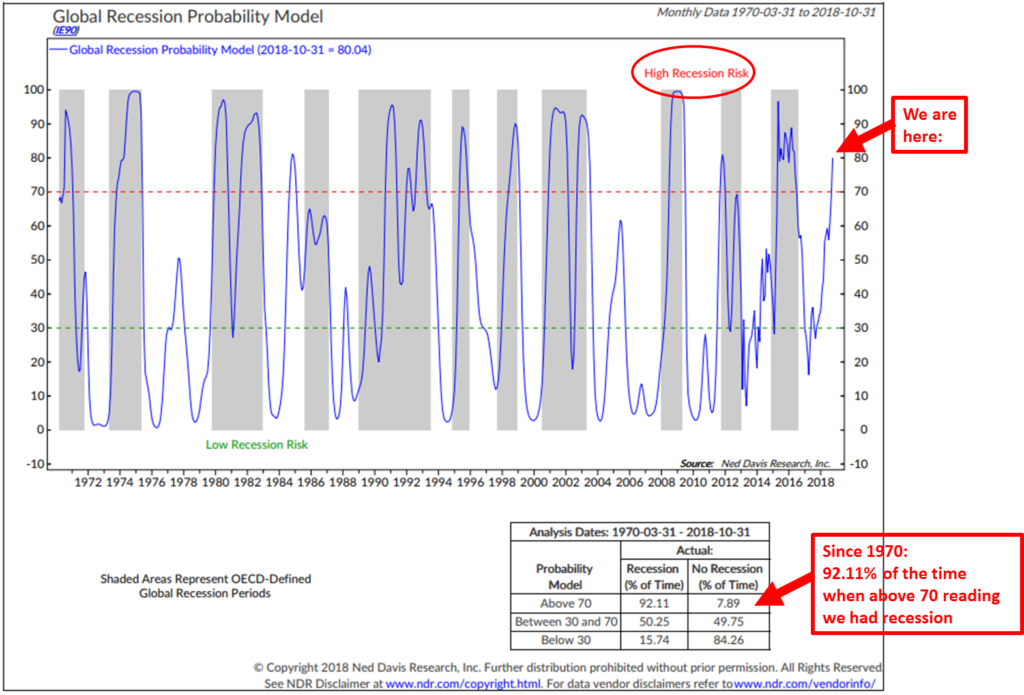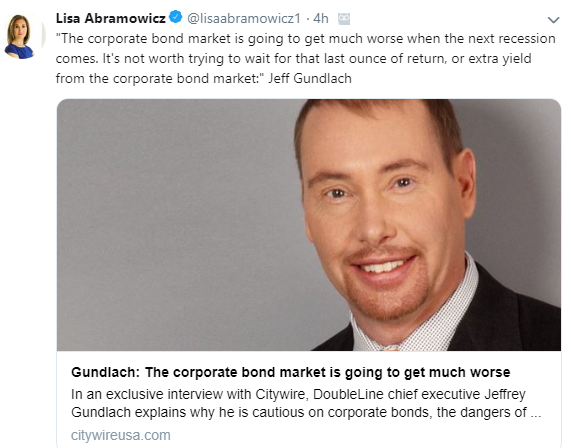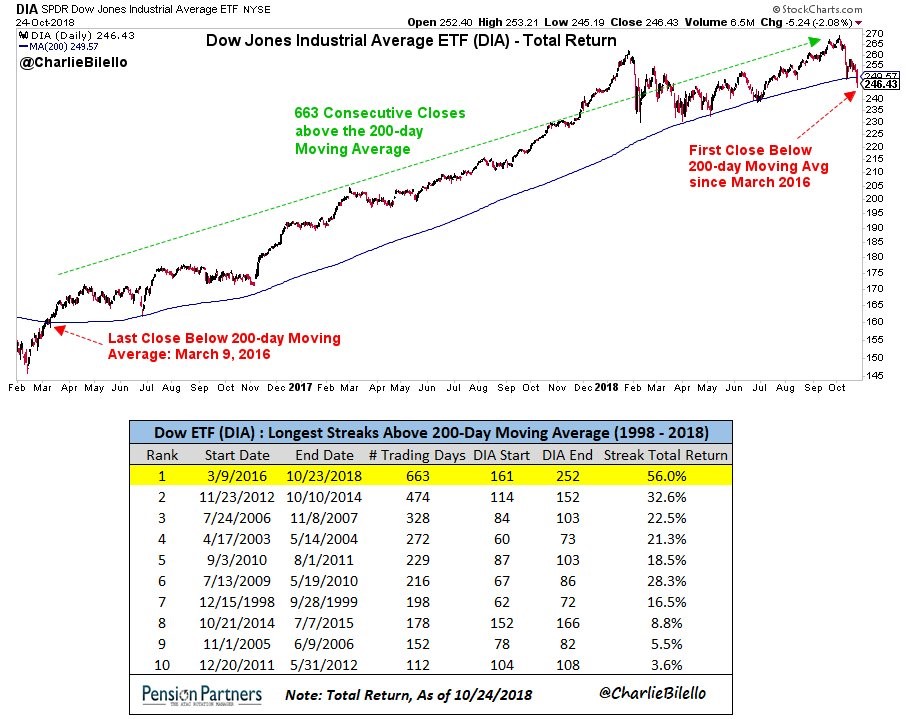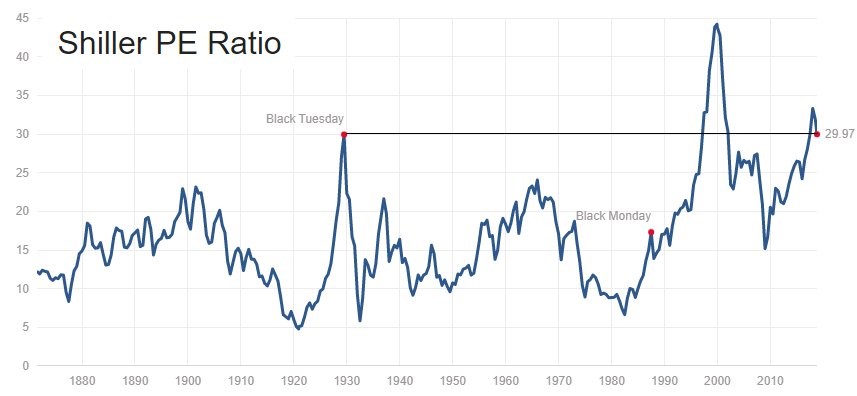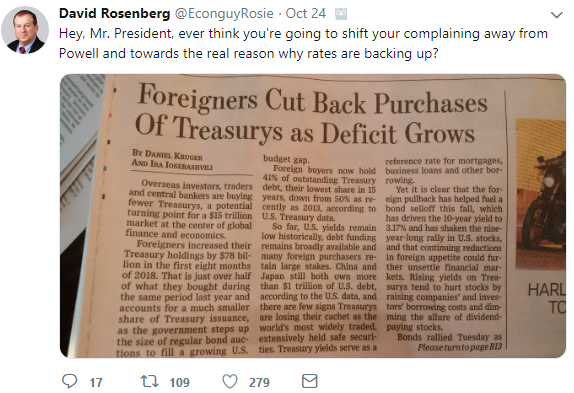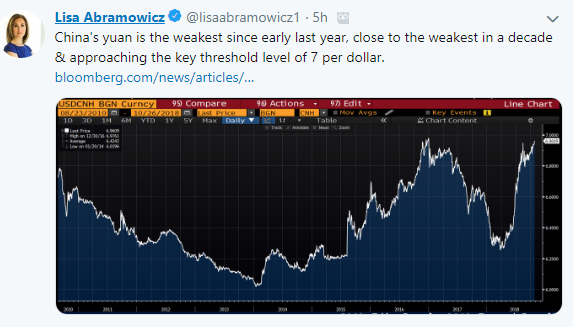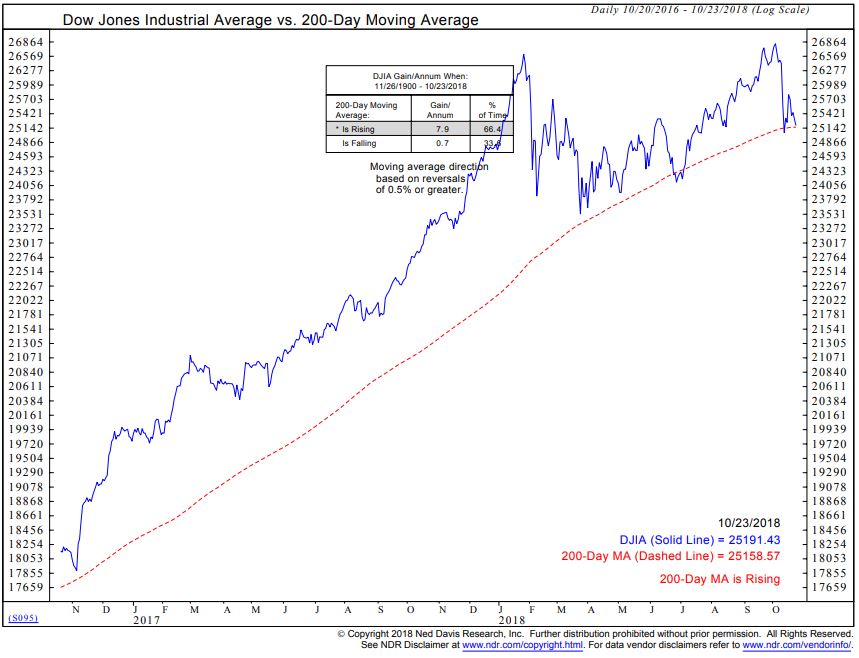“It is essential for everyone to understand the logical sequence of events that makes these (big debt crises) all play out all the same.” – Ray Dalio
“Years of monumental Quantitative Easing / Negative Interest Rates monetary policy affected the behavioral patterns of investors and changed the structure itself of the market, in what accounts as self-amplifying positive feedbacks.” – Francesco Filia
Q3 hedge fund letters, conference, scoops etc
Self-amplifying is positive on the way up. Self-amplifying is negative on the way down. Just a few stocks took the market higher. After the close, one of those stocks, Amazon, reported revenue below forecasts. Amazon is 7.20% lower today and down nearly 18% in three short weeks. Risk is greatest when valuations are highest, when bull markets are aged, when debt is high, when the Fed is tightening and interest rates are rising. Our starting conditions matter. A month ago I wrote, “It’s going to get bumpy.” It just got bumpy.
The global markets fell sharply this week and last. Since their January 25, 2018 highs, developed market equities (“EFA”) are down 17.5% and emerging market equities (“EEM”) are down 24%. U.S. equities (“SPY”) are down 4.50% from the January 25, 2018 high and down 7% from the all-time high made on September 20, 2018. SPY is up 1% on the year.
Most broad market averages have broken below their 200-day moving average trend lines. In last week’s piece, Critical Tipping Points, I shared my “Dashboard of Indicators” with you. The most important of the indicators, in my view, are the recession indicators. Why? Funding dries up, bankruptcies accelerate and equity markets decline 37% on average. $1 million drops to $630,000. The last two recessions saw the S&P 500 decline more than 50%. Tech dropped 75% from 2000 to 2002. The problem for pre-retirees and retirees is in the math. A 37% decline requires a 59% return just to get back to even. How many years will that take? Starting conditions matter.
Global Recession Watch
The most pressing economic challenges currently reside outside of the U.S. With generous permission from my friends at Ned Davis Research, I shared the following chart last week. It contains a wide range of economic indicators such as money supply, yield curve, building permits, consumer and business sentiment, share prices, and manufacturing production. There are usually five to 10 indicators, which vary by type and weight, depending on the country, and are selected based on economic significance, cyclical behavior and quality.
Bottom line: The world is in slowdown and the probability for a global recession is now over 80%. When the reading is this high, a recession has occurred 92% of the time. I suspect recession has started. Here’s the chart:
My Personal View of What’s Happening and What the Road Ahead Looks Like
The stock market is the best leading indicator for the economy. Most people say the economy is OK, so I should buy stocks, but it is really the other way around. The best buys are when the economy is coming out of recession, not when it is strong. Were you better off buying stocks in 2009 or 2018? January 26, 2018 was the peak of the All Country World Index and the global recession probability chart began signaling global recession a month ago. Stocks lead. If the world catches the flu, the U.S. is likely to catch the flu. The U.S. equity market peaked in September. Since stocks are a leading economic indicator, the October sell-off should turn our recession watch lights on high. Currently, there is no sign of U.S. recession.
Rates are rising. The recent interest rate move was a clear shot across the bow. See Trade Signals – The 3.07% Line in the Sand is Crossed; Expect Bumps. Debt is the problem. Rising rates squeeze borrowers. Underfunded pensions will soon be front page news. Low rates have starved pension plan returns. Over the next 10 years, we’ll have to reset the debt and restructure the pension plans. Both are not good for economic growth. I expect stocks will be down more than 50% in the next recession. I believe there is time to prepare, position and profit.
Short term picture: Typically what you see when you get a broadening global decline is a test of the lows and then the market is going to rally. We are testing lows now. The immediate question is whether we break the lows or rally into year end. A break of the lows will set off more selling. Then a rally to re-test that support line is likely. I’d say we are in the seventh or eighth inning. Recession will come in the ninth. Bigger problems in mid to late 2019.
What to do? More defense than offense and have a risk-minded game plan in place. Put the offense back on the field when everyone is panicking. Blood in the streets like 2008-2009. I favor diversifying to trading strategies vs. diversifying to asset classes. Risk manage core holdings with some form of longer-term stop-loss exit and entry process. Absent anything else, the 200-day moving average rule is good; however, I favor the Ned Davis Research CMG Large Cap Long/Flat indicator for large-cap and mid-cap stock exposures. For bonds, I believe risk management is called for as rising rates and rising inflation are bad for bond returns. I watch the Zweig Bond Model signal and my HY signals every day. Both are signaling exposure to Treasury bills.
For me, and I imagine many of my pre-retiree and retired Baby Boomer friends, it’s about getting my core holdings from here to the other side of what John Mauldin is famously calling “The Great Reset.” Debt and pension restructuring will be in our near future. Core for me is a process that seeks growth but does so in a way to minimize downside loss. I like to think in terms of a risk budget for an overall portfolio. For example, if one invests 80% of a $1 million portfolio in a diversified “participate-and-protect” investment approach and 20% or $200,000 in select return accelerators (liquid or private investment opportunities), the $800,000 will grow back to $1 million in a little more than six years at a 4% annualized return and sooner if returns are 5%, 6% or 7%. The idea with the $200,000 is to find four or five big return accelerators. They may be in biotechnology, venture capital or real estate.
I like thinking about sizing portfolios to protect what I’ve got and do so in a way that can grow my personal wealth. Select opportunities can make a difference and psychologically, the 80%/20% game plan make my emotional ride a little easier. One keeps my wealth smartly on path while the other can accelerate my wealth. For select opportunities, I look for 5x to 10x upside potential. Unfortunately, there are certain net worth requirements and one needs a deep and trusted network. Of course, you may like 70/30 or 50/50 or 90/10. It’s important to talk to your advisor and figure out your particular risk tolerance, individual/family needs, specific goals and time horizon. Send me an email if you have any questions. Note: exceptional doesn’t guarantee they’ll be exceptional but I feel my plan keeps my wealth intact (core) while providing me and my family considerable upside potential.
Think Opportunity
“It is essential for everyone to understand the logical sequence of events that makes these (big debt crises) all play out all the same.” – Ray Dalio
If you missed my letters reviewing Ray Dalio’s Template for Understanding Big Debt Crises or if you read with great interest, I encourage you to watch/listen to (or better yet put your sneakers on, plug in your earbuds and take a walk) this 16-minute Ray Dalio Bloomberg interview. Bloomberg’s Erik Schatzker sat down with Dalio post-reading the Template. It is about where we are in the current debt cycle and what you can do.
Put your “return accelerator” hat on. Dalio’s Template is an X’s and O’s game plan to position and profit from the opportunities that big debt crises create. Ray believes we are in roughly the seventh inning of the current long-term big debt crisis cycle. There’s still time to prepare and position. Dalio says there are two types of debt crises: one is inflationary and other is deflationary. Which one you get depends on if the debt owed is financed in its home currency. All of this happens in a mechanical way. It’s about process and game plan… not fear or worry.
Click image for link to video.
Forget the coffee this week and grab a beer. It’s been bumpy, but family and good friends matter most. Let’s celebrate and enjoy life’s ride. When you click through below, you’ll find a few more charts and a summary of the Big Bets section I wrote about last week… in case you missed the post. Wishing you the best and have a great weekend!
♦ If you are not signed up to receive my weekly On My Radar e-newsletter, you can subscribe here. ♦
Follow me on Twitter @SBlumenthalCMG
Included in this week’s On My Radar:
- Miscellaneous Charts of the Week
- Why This Matters
- Big Bets
- Trade Signals – Extreme Investor Pessimism S/T Bullish For Equities, Equity Trend Modestly Bullish, Bond Trend Bearish
- Personal Note
Miscellaneous Charts of the Week
The European Central Bank will press ahead with plans to phase out easy money policies this year despite mounting risks, including Brexit and a fight over Italy’s budget that are blurring the region’s economic outlook.
Italy crisis is brewing: Draghi reiterated that Italy is on its own with respect to the budget standoff. The ECB is not getting involved in the negotiations and will not be in the business of supporting Italian bond prices. The euro sold off some more:
The U.S. dollar continues to grind higher, which, in combination with elevated rates and credit spreads. U.S. financial conditions are tightening. Higher rates, high dollar = watch EM countries who have borrowed debt in dollars.
And the new “Bond King”:
Longest streak above the 200-day MA line broken:
Valuations remain high — even after recent sell-off (matching 1929 high):
Debt remains issue number one. In the U.S. and globally:
Here is one of those sellers of U.S. Treasury bonds — China:
And recall the last time (January 2016) their currency reached this level…
Bumpy indeed! OK – go grab another cold beer!
Why This Matters
Worth the read if you missed this from last week’s post:
From Ambrose Evans Pritchard – The Telegraph
Big Bets
This is a reprint of what I shared last week, in case you missed it.
Last week I shared my bullet point notes from a Felix Zulauf Barron’s article. He shared several ideas, most of which I agree with. You can find that post here.
I’m uber-focused on recessions because that’s when the bad stuff tends to happen. As long as rates are low and funding ability is high, then the party moves on. However, zero interest rate policy (“ZIRP”) has caused investors to stretch for yields and take on risks I don’t believe many fully understand. When the liquidity music stops (Fed, ECB, JCB, tax cuts, etc.), the markets will reset. The key trigger in all of this may be rising interest rates.
Debt is the central theme. We are at the end of a long-term debt cycle. That’s where I believe we’ll find the next great short opportunities. Ideas:
- Short High Yield Junk Bonds – Far too many companies received financing. Covenant quality is a bad as it’s ever been. Defaults will be epic and they will occur in the next recession when companies living on debt will no longer find funding. Watch the U.S. recession indicators and use a trend following buy/sell trigger.
- Short Emerging Market Dollar Denominated Debt
- Short Italy, short Italian banks, short eurozone equities, short European banks and short the euro currency vs. the dollar. As Zulauf said last week, and I concur,
On the Euro – Right on point! Watch the banks!
- Introducing the euro led to forced centralization of the political organization as imbalances created by the monetary union must be rebalanced through a centralized system. As nations have different needs, the people are revolting; established parties are in decisive decline and anti-establishment organizations are rising.
- The risk of a hard Brexit is high. Italy doesn’t listen to Brussels any longer. The March election brought anti-establishment parties to power that proposed a budget with a 2.4% deficit target. Eventually it will be closer to 4%. The Italian banking system holds €350 billion of government bonds. If 10-year government bond yields hit 4%, banks’ equity capital will just about equal their nonperforming loans.
- By the middle of next year, you’ll see more fiscal stimulation in Germany, Italy, France, and possibly Spain. Governments will not care about the EU’s directives. The EU will have to change, giving more sovereignty to individual nations. If Brussels remains dogmatic, the EU eventually will break apart.
The European Central Bank
- ECB quantitative easing ends by the end of this year. The economy has been doing well, the inflation rate has risen, and yet the ECB has continued with aggressive monetary easing, primarily financing the weak governments. This is nonsense.
- They are the worst-run central bank in the world. I expect the euro to weaken further, possibly to $1.06 from a current $1.15.
“Global fiscal stimulus initiatives are poison for bond markets. Bond yields are rising around the world. After major new fiscal stimulus programs are announced, perhaps from mid-2019 onward, yields will rise quickly, resulting in a decisive bear market in bonds.” – Felix Zulauf
Bottom line: All of this means a lot of liquidity is being withdrawn from the market, which is bearish for financial assets. How much of a decline? We don’t know. Zulauf sees maybe 25% to 30% from the top, taking nearly all other markets down with them. I’m in the -40% to -70% camp. When the declines are big enough, the central planners will come in. Central banks will ease monetary policy, buying assets if necessary. We’ll want to cover shorts and move big bets to the long side when that day comes.
Trade Signals – Extreme Investor Pessimism S/T Bullish For Equities, Equity Trend Modestly Bullish, Bond Trend Bearish
It is my view that the market is in the early innings of a long-term secular topping process. The secular bull is aged, overvalued, interest rates are rising and we have a different Fed in charge. A Fed that will let the market stand on its own for now. The boost from tax cuts and the repatriation of offshore corporate cash likely supports the continuation of corporate share buybacks (already at a record). Absent recession, war or systemic shock, there remains risk of a U.S. equity market melt up before the next recession brings its challenges to the downside.
Key point is the market is late cycle. Risk is high. The market is testing the 200-day moving average (MA) lines. The DJIA remains slightly above and the S&P 500 Index slightly below. A short-term technical positive is the extreme level of investor pessimism.
DJIA vs. 200-day MA (dashed red line is the 200-day MA)
S&P 500 Index vs. 200-day MA (broke below dashed 200-day MA line, see upper right of chart)
A test of the February 2018 lows is probable prior to a year-end rally. No guarantees of course… just my two cents. I’m sticking to my indicators/risk-managed process and diversifying to trading strategies. The Ned Davis Research CMG U.S. Large Cap Long/Flat Index remains in a buy, the Zweig Bond Model and the CMG Managed High Yield Bond Program remain in sell signals. The CMG Beta Rotation Strategy is currently invested in low beta utilities, the CMG Opportunistic All Asset Strategy is in cash, the CMG Tactical Equity Strategy is also in cash and the CMG Mauldin Smart Core Strategy is overweight cash and underweight equities and fixed income.
Click here for this week’s Trade Signals.
Important note: Not a recommendation for you to buy or sell any security. For information purposes only. Please talk with your advisor about needs, goals, time horizon and risk tolerances.
Personal Note
I’ll be doing some writing this weekend as I’m working on a book. A first for me and honestly I’m enjoying the process so far. Rain is coming through tomorrow so that will make for a good book writing day. Youngest Kieran has a soccer game tomorrow. I find myself with so much more time on my hands now that four of our boys are in college and Brianna is living and working in NY. Really mixed emotions and Susan and I do find we are adjusting. So really looking forward to Kieran’s game. Go Friars!
No travel plans next week. Denver follows November 5-7.
Wishing you a wonderful weekend!
♦ If you are not signed up to receive my weekly On My Radar e-newsletter, you can subscribe here. ♦
With kind regards,
Steve
Stephen B. Blumenthal
Executive Chairman & CIO
CMG Capital Management Group, Inc.

